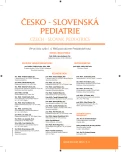Long-term experience from iodine intake monitoring in neonatal population in the Czech Republic
Authors:
O. Hníková 1; H. Vinohradská 2; P. Dejmek 1; Al Taji E.klinika Dětí 1; Dorostu; Uk . Lf 3; Fn Královské Vinohrady; doc. MUDr. Prahapřednosta F. Votava, Ph.D.
Authors‘ workplace:
Klinika dětí a dorostu, UK 3. LF a FN Královské Vinohrady, Prahapřednosta doc. MUDr. F. Votava, Ph. D.
1; Oddělení klinické biochemie, pracoviště Dětská nemocnice, MU LF a FN, Brnoprimář doc. MUDr. M. Dastych, CSc
2
Published in:
Čes-slov Pediat 2014; 69 (4): 228-233.
Category:
Original Papers
Overview
Neonatal population is in significantly higher risk of iodine deficiency (ID). Iodine saturation in newborns has been followed in the Czech Republic (CR) since 1991. In a pilot study in Prague 10 which included 50 neonates and their mothers, the median urinary iodine concentration observed on the 5th day after birth, revealed mild ID, according the WHO, UNICEF and the International Council for Control of Iodine Deficiency Disorders (ICCIDD). Grant supported study followed in 3 regions of CR (1993–95), ie. in Prague, Pribram and Ustí n. L. In each region ioduria, thyroid stimulating hormone (TSH), thyroxine (T4) measurements and thyroid ultrasound were performed in 50 neonates and their mothers. Median ioduria results were not consistent in three regions, varying from mild to middle ID. After extension of preventive measures, including recommendation of 100 μg of iodine/day in pregnant mothers, median ioduria values were close to normal in a study from 1997. Iodine saturation monitoring of neonatal population in CR has been initiated in 1996, using neoTSH method from neonatal screening for congenital hypothyroidism (SCH), according to WHO, ICCIDD and UNICEF. The adequate iodine saturation was evident if in less then 3% of newborns neoTSH was elevated in range 5,0–20,0 mIU/L. Blood samples were taken at 72–96 hours post partum (pp.). Since the year 2006 normal iodine intake, less than 3% of elevated neoTSH, was observed in newborns of CR until the end of September in 2009. Since October 1st 2009, new measures were introduced in neonatal screening in CR. Blood samples are taken earlier, ie. 48–72 hours pp. The percentage of newborns with neoTSH 5,0–20,0 mIU/L has doubled with earlier blood sampling and remained stable within this range during next years 2010–2013. The likely reason of this postpartum increase in neoTSH is associated with earlier sampling and intervention with after birth TSH elevation.
In conclusion:
neoTSH method for monitoring of iodine saturation in newborn population, using neoTSH 5,0–20,0 mIU/L from SCH, has been proven as an ideal method, reliable, cheap with easy organization in a long-term follow up. Earlier blood sampling (48–72 hours pp.) increased the upper range of normal iodine intake to 6% instead to 3% neoTSH (5,0–20,0 mIU/L) in newborn population of CR. Ongoing education, emphasizing iodine importance and its correct supply is crutial for pregnant and lactating mothers.
Key words:
iodine deficiency in newborn population, disorders of mental development, preventive measures, monitoring, change in neoTSH monitoring with earlier sampling H.
Sources
1. Zamrazil V, Pohunková Z, Bednář J, et al. Současný stav jódového deficitu v ČR. Čas Lék čes 1992; 131: 24–25.
2. Glinoer D, Labourer D, Delange F, et al. Maternal and neonatal thyroid functions in condition of marginally low iodine intake. In: Progress in Thyroid Research (Eds Gordon, Gross and Hennemann). Rotterdam: Baltzena, 1991: 165–168.
3. Pharoah POD, Connoly KJ. Effects of maternal iodine supplementation during pregnancy. Arch Dis Child 1991; 66: 145–147.
4. Hníková O, Zikmund J, Kračmar P, et al. Pilotní studie jódového zásobení u rizikových skupin obyvatelstva v Praze 10. Čes-slov Pediat 1994; 49 (9): 323–327.
5. Hníková O, Zikmund J, Janečková M, et al. Epidemiologická studie jódového zásobení u novorozeneců a jejich matek ze tří oblastí České republiky v letech 1993–1995. Čes-slov Pediat 1996; 51 (3): 131–141.
6. Hníková O, Hromádková M, Wiererová O, Bílek R. Kontrolní studie jódového zásobení novorozenců a jejich matek ze dvou oblastí ČR po třech letech nápravných opatření. Čas Lék čes 1999; 138 (9): 272–275.
7. Constante G, Grosso L, Ludovico O, et al. The statistical analysis of neonatal TSH results from congenital hypothyroidism screening programmes provide a useful tool for the characterization of moderate iodine deficiency regions. J Endocrinol Invest 1997; 20 (5): 251–256.
8. Hníková O. Význam trvalého správného jódového zásobení pro mladou generaci. Vox Pediat 2001; 1 (7): 30–32.
9. Hníková O. Význam neonatálního TSH. Čes-slov Pediat 2003; 58 (5): 252–254.
10. Hníková O, Delange F, Kračmar P, et al. Experience in the monitoring of maternal and neonatal iodine supply in the Czech Republic. Čes-slov Pediat 2005; 60 (1): 3–6.
11. Dluholucký S, Knapková M, Cibirová M, Hrubá F. Hodnotenie zvýšených hladin neonatálneho skríningového TSH na Slovensku. Čes-slov Pediat 2006; 61 (9): 524–529.
12. Freize C, Ramos R, Amaya E, et al. Newborn TSH concentration and its association with cognitive development in healthy boys. Eur J Endocrinol 2010; 163: 901–909.
13. Krylová K, Neumann D, Al Taji E, et al. Vliv jódového stavu a mateřských tyreopatií na vývoj štítné žlázy a jeho poruchy u plodu a novorozence. Čes-slov Pediat 2013; 68 (4): 260–265.
Labels
Neonatology Paediatrics General practitioner for children and adolescentsArticle was published in
Czech-Slovak Pediatrics

2014 Issue 4
Most read in this issue
- Alagille syndrome
- Clinical and biochemical characteristics of Kawasaki syndrome in 22 children
- Drug induced aseptic meningitis and Lyell syndrome: Rare causes of headache and exanthema in adolescents
- Acute and delayed adverse effects of gentamicin in the treatment of premature neonates with sepsis during the first postnatal week – an open prospective study (part II)
